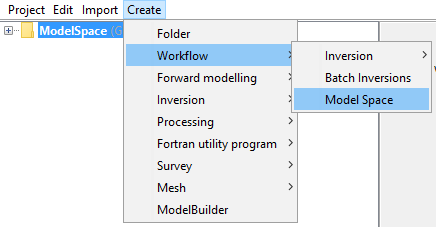4.6.3. Model Space
With the Model Space Workflow, the user can explore the solution space
associated with underdetermined inverse problems. The workflow proceeds with a
series of inversion over a range of parameter values. The resulting models can
be visualized and compared along set cross sections.

Create → Workflow → Model Space
4.6.3.1. Set inversion object
This option will prompt a menu for the selection of an Inversion object
used as a template for all subsequent inversions. Only the inversion parameter
under investigation will be altered for subsequent inversions
Workflow → Set Template

4.6.3.2. Edit Options
This option sets the range of inversion parameters to iterate over.
Values for \(\alpha\), \(m_{ref}\), \(m_{0}\) are available for all inversion objects.
MAGINV3D_v6 and GZINV3D_v6 allow for sparsity on model values \(p\)-value and model gradients \(q\)-values.
Workflow → Edit Options

4.6.3.3. Write All
This option creates the files and directories needed for the individual inversions These are stored to disk, along with a Python script for the execution.
Workflow → Write all
4.6.3.4. Run
Workflow → Run
4.6.3.4.1. OPTION 1: Run locally
Just as for any other inversion programs, the Fortran executable can be called locally. Make sure you have sufficient resources to run the inversion.
4.6.3.4.2. OPTION 2: Run remotely
To run the inversion on a remote computer, the user will need to
copy the content of the inversion directory as well as the
BatchInversion.py script.
To run the script type in a command line:
python BatchInversion.py [Directory] [FortranCode]
where:
[Directory]is the relative path between the python script and the input files. If the same folder, use.\
[FortranCode] is name of the inversion routine to be used (e.g. dcinv2d, maginv3d)
4.6.3.5. Load All
Selecting this option triggers GIFtools to seek for results in the
corresponding list of directories associated with individual inversion
objects. If the inversion was run on a remote machine, the directories must be
copied in the working directory of the parent BatchInversion. Only the
last model and predicted will be loaded, but convergence curves can be viewed.
Workflow → Load All
4.6.3.6. Export Section
In order to compare multiple models at once, individual sections can be exported using the Model Extraction tool.
Workflow → Extract Sections